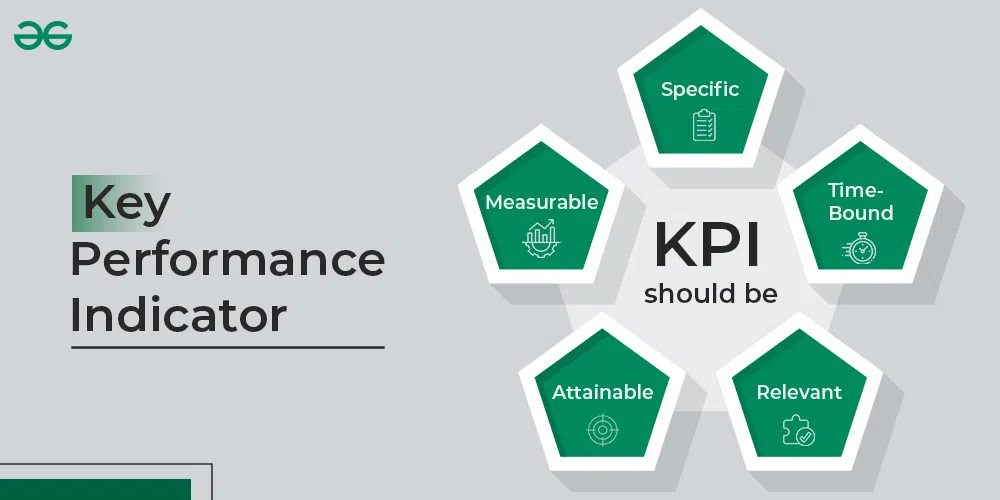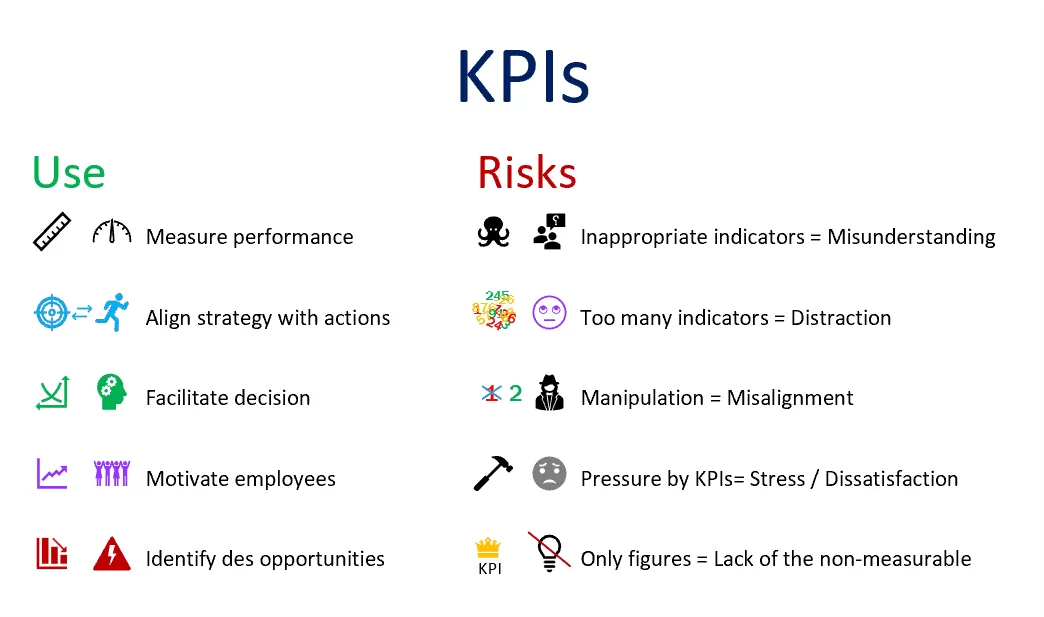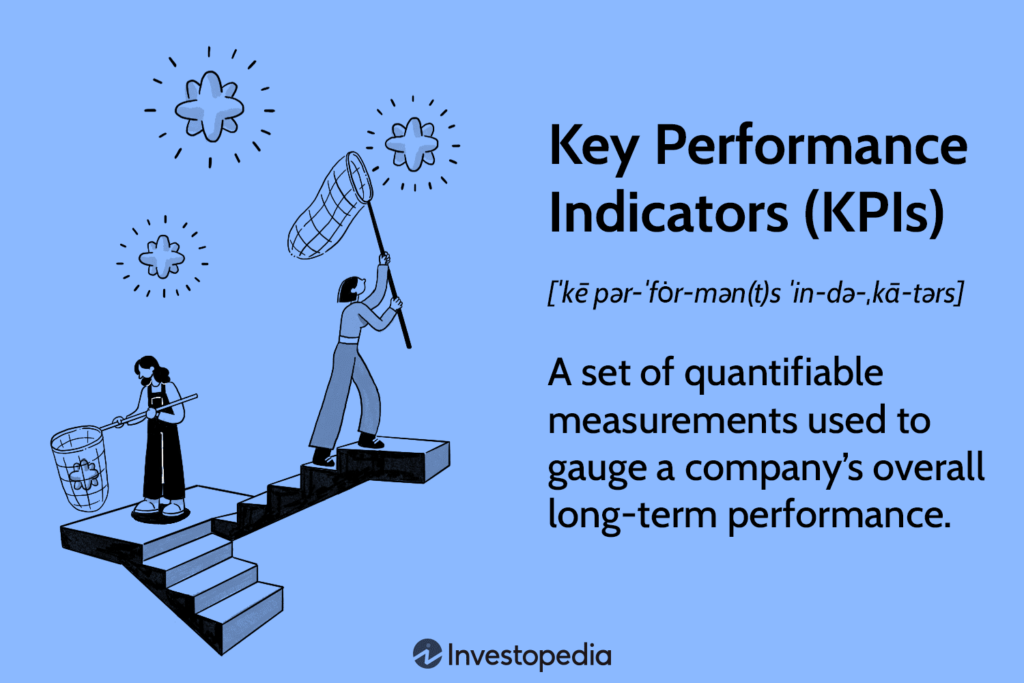Key Performance Indicators (KPIs) are measurable values that demonstrate how effectively an organization achieves its key business objectives. They help in tracking performance and guiding decision-making.
KPIs serve as essential tools for businesses aiming to assess their success and drive growth. By quantifying performance, organizations can set clear goals and monitor progress effectively. Different types of KPIs focus on various aspects, such as financial performance, customer satisfaction, and operational efficiency.
For instance, common KPIs include revenue growth, profit margins, and client retention rates. Understanding and utilizing KPIs enables businesses to identify strengths and weaknesses, fostering continuous improvement and strategic decision-making. Ultimately, KPIs are vital for ensuring alignment between daily operations and long-term objectives.
The Essence Of Kpis In Business
Key Performance Indicators, or KPIs, are vital for any business. They measure progress and success. KPIs help organizations understand their performance. They guide decision-making and strategy. This section explores the essence of KPIs in business.
Defining Kpis
KPIs are specific metrics that indicate how well a company is performing. They provide measurable values that reflect goals. Each KPI should be:
- Specific: Clearly defined and focused.
- Measurable: Quantifiable to track progress.
- Attainable: Realistic and achievable.
- Relevant: Aligned with business objectives.
- Time-bound: Set within a specific timeframe.
Examples of common KPIs include:
| KPI | Description |
|---|---|
| Revenue Growth | Measures increase in sales over time. |
| Client Retention Rate | Percentage of clients retained over a period. |
| Customer Satisfaction | Evaluates customer feedback and satisfaction levels. |
| Profit Margin | Shows profit as a percentage of revenue. |
Importance In Strategic Planning
KPIs play a crucial role in strategic planning. They help businesses set clear goals. By tracking KPIs, organizations can:
- Identify strengths and weaknesses.
- Make informed decisions.
- Adjust strategies based on performance.
- Enhance overall performance.
Using KPIs, businesses can stay aligned with their vision. They ensure that every team member understands their role. This alignment boosts morale and productivity.
In summary, KPIs are essential for measuring success. They provide clarity and direction in business operations.

Credit: www.geeksforgeeks.org
Types Of Kpis
Key Performance Indicators (KPIs) serve as vital tools for measuring the success of an organization. Different types of KPIs focus on various aspects of performance. This section explores the main categories of KPIs, helping businesses understand their strengths and areas for improvement.
Financial Metrics
Financial metrics are critical for evaluating a company’s economic health. These KPIs help track profitability and revenue. Common financial metrics include:
- Revenue Growth: Measures the increase in revenue over time.
- Profit Margin: Indicates how much profit a company makes for every dollar of sales.
- Return on Investment (ROI): Assesses the profitability of an investment.
| Financial Metric | Description |
|---|---|
| Revenue Growth | Increase in revenue compared to previous periods. |
| Profit Margin | Profit earned from each dollar of sales. |
| Return on Investment (ROI) | Profitability measure for investments. |
Customer Engagement Indicators
Customer engagement indicators measure how well a company interacts with its customers. These KPIs help in understanding customer satisfaction and loyalty. Important indicators include:
- Customer Satisfaction Score (CSAT): Gauges customer satisfaction through surveys.
- Net Promoter Score (NPS): Measures customer loyalty and likelihood to recommend.
- Customer Retention Rate: Tracks the percentage of customers retained over time.
Operational Performance Metrics
Operational performance metrics focus on the efficiency of business processes. These KPIs help identify bottlenecks and optimize operations. Key operational metrics include:
- Cycle Time: Time taken to complete a process.
- Order Fulfillment Rate: Percentage of orders delivered on time.
- Inventory Turnover: Measures how often inventory is sold and replaced.
Employee Performance Measures
Employee performance measures evaluate individual and team contributions. These KPIs help improve workforce productivity and morale. Common measures include:
- Employee Satisfaction Score: Assesses how satisfied employees are with their job.
- Training Effectiveness: Measures the impact of training on performance.
- Employee Turnover Rate: Tracks the rate at which employees leave the company.
Establishing The Right Kpis
Choosing the right Key Performance Indicators (KPIs) is essential for any business. KPIs help track progress and measure success. They provide clear goals and focus efforts. Without the right KPIs, businesses may struggle to understand their performance.
Aligning Kpis With Business Objectives
Aligning KPIs with business objectives ensures that each metric supports overall goals. This alignment keeps teams focused and motivated. Here are some steps to achieve this:
- Identify Business Goals: Understand your main objectives.
- Define Relevant KPIs: Choose metrics that reflect those goals.
- Involve Stakeholders: Get input from team members for better alignment.
- Regular Review: Reassess KPIs to stay relevant as goals evolve.
Example of aligned KPIs:
| Business Objective | Aligned KPI |
|---|---|
| Increase Sales | Monthly Revenue Growth |
| Improve Customer Satisfaction | Net Promoter Score (NPS) |
| Enhance Team Efficiency | Project Completion Rate |
Setting Smart Kpis
SMART KPIs provide a clear framework for setting effective metrics. The acronym stands for:
- Specific: Clearly define what you want to measure.
- Measurable: Ensure the KPI can be tracked.
- Attainable: Set realistic targets.
- Relevant: Align KPIs with business objectives.
- Time-bound: Set a deadline for achievement.
Examples of SMART KPIs include:
- Increase website traffic by 20% in six months.
- Acquire 50 new customers each quarter.
- Reduce customer service response time to under 2 hours.
Using the SMART criteria improves focus and accountability. It ensures that every KPI drives performance effectively.

Credit: www.wevalgo.com
Common Kpis Across Industries
Key Performance Indicators (KPIs) play a vital role in evaluating success. Across various industries, certain KPIs remain common. These metrics help organizations monitor performance and achieve their goals. Understanding these KPIs aids in better decision-making and enhances productivity.
Revenue Growth And Profit Margins
Revenue growth measures how much a company’s income increases over time. It shows the effectiveness of sales strategies and market demand.
Profit margins indicate the percentage of revenue that exceeds expenses. High profit margins suggest a company is efficient in its operations.
| Type | Importance |
|---|---|
| Revenue Growth | Indicates market demand and sales effectiveness. |
| Profit Margins | Measures operational efficiency and financial health. |
Customer Satisfaction And Retention
Customer satisfaction gauges how products or services meet expectations. High satisfaction often leads to repeat business.
Customer retention measures the ability to keep customers over time. High retention rates indicate strong customer loyalty.
- Surveys and feedback help assess satisfaction.
- Retention strategies include loyalty programs.
Internal Process Quality
Internal process quality focuses on how well a company operates its processes. Efficient processes lead to improved productivity.
Measuring this KPI helps identify bottlenecks and areas for improvement.
- Identify key processes.
- Set benchmarks for quality.
- Monitor performance regularly.
Companies can enhance their internal processes by implementing regular reviews. This will lead to better overall performance and customer satisfaction.
Interpreting Kpi Data
Interpreting KPI data is crucial for understanding business performance. Effective analysis helps organizations identify strengths and weaknesses. It also guides future strategies. This section covers two important aspects: analyzing trends over time and benchmarking against industry standards.
Analyzing Trends Over Time
Analyzing trends is essential for recognizing patterns in KPI data. Tracking changes over time provides valuable insights. Here are key steps for effective trend analysis:
- Collect Data Regularly: Gather data at consistent intervals.
- Visualize Data: Use graphs or charts to illustrate trends.
- Identify Patterns: Look for recurring trends or anomalies.
- Compare Periods: Assess performance against previous periods.
For instance, consider the following table that shows a sample KPI trend:
| Month | Revenue Growth (%) | Customer Satisfaction Score |
|---|---|---|
| January | 5 | 85 |
| February | 7 | 87 |
| March | 6 | 90 |
This table shows improvements in revenue growth and customer satisfaction. Continuous monitoring reveals overall business health.
Benchmarking Against Industry Standards
Benchmarking provides context for KPI performance. It compares your KPIs to industry standards. This process highlights areas for improvement. Here are steps to benchmark effectively:
- Identify Relevant Metrics: Focus on KPIs that matter most.
- Research Industry Data: Use reports and studies for comparison.
- Analyze Gaps: Find discrepancies between your performance and industry averages.
- Set Improvement Goals: Establish targets based on findings.
For example, if your customer satisfaction score is 80% and the industry average is 90%, aim to close that gap. This proactive approach enhances competitiveness.
Challenges In Kpi Implementation
Implementing Key Performance Indicators (KPIs) can be tricky. Many organizations face obstacles. These challenges can hinder the effectiveness of KPIs. Understanding these issues is vital for success.
Avoiding Common Pitfalls
Many companies stumble when setting up KPIs. Here are common pitfalls to avoid:
- Vague Objectives: KPIs must be clear and specific.
- Too Many KPIs: Focus on a few critical indicators.
- Neglecting Team Input: Involve your team in the KPI process.
Ensuring Data Accuracy
Accurate data is essential for KPIs. Incorrect data leads to poor decisions. Here are tips to ensure data accuracy:
- Regular Audits: Perform frequent data checks.
- Use Reliable Sources: Gather data from trusted platforms.
- Standardize Data Entry: Follow consistent formats for data.
| Data Accuracy Tips | Benefits |
|---|---|
| Regular Audits | Identifies errors early. |
| Use Reliable Sources | Builds trust in data. |
| Standardize Data Entry | Reduces inconsistencies. |
Technology’s Role In Kpi Tracking
Technology has transformed how businesses track and analyze their Key Performance Indicators (KPIs). With the right tools, organizations can access real-time data. This leads to informed decisions and improved performance. As businesses grow, so does the complexity of tracking KPIs. Technology streamlines this process, making it easier and more efficient.
Leveraging Data Analytics Tools
Data analytics tools play a crucial role in KPI tracking. They collect vast amounts of data from various sources. Here are key benefits of using these tools:
- Real-time monitoring: Track KPIs as they happen.
- Data visualization: Turn complex data into easy-to-read charts.
- Historical analysis: Compare past performance with current data.
- Custom reports: Generate tailored reports for specific needs.
Popular data analytics tools include:
| Tool | Key Features |
|---|---|
| Google Analytics | Website traffic analysis and user behavior tracking. |
| Tableau | Visual analytics and business intelligence. |
| Power BI | Interactive dashboards and data visualization. |
Automating Kpi Reporting
Automation simplifies KPI reporting. Manual tracking consumes time and resources. Automating this process offers numerous advantages:
- Time-saving: Reduce manual work with automated reports.
- Consistency: Ensure uniformity in reporting.
- Accuracy: Minimize human errors in data entry.
- Accessibility: Share reports easily with stakeholders.
Many tools can automate KPI reporting:
- Google Data Studio
- Microsoft Power Automate
- Zapier
These tools connect various data sources. They generate regular reports automatically. This keeps everyone informed and aligned with business goals.
.png)
Credit: www.geeksforgeeks.org
Continuous Improvement Through Kpis
Key Performance Indicators (KPIs) drive continuous improvement in organizations. They offer measurable data that guides decision-making. By focusing on specific metrics, businesses can enhance performance and achieve goals. This process creates a culture of accountability and growth.
Using Kpis For Decision Making
KPIs provide essential data for informed decision-making. They help teams understand performance and identify areas needing improvement. Here are some ways to effectively use KPIs:
- Set Clear Objectives: Define what success looks like.
- Monitor Progress: Regularly review KPI data.
- Engage Teams: Involve team members in discussions.
- Adjust Strategies: Use data to refine approaches.
Decisions based on KPI insights can lead to:
- Increased efficiency
- Enhanced productivity
- Better resource allocation
Adapting Kpis To Changing Business Environments
Business environments change rapidly. Adapting KPIs ensures relevance and effectiveness. Here are ways to adjust KPIs:
- Regular Reviews: Analyze KPI performance frequently.
- Stakeholder Input: Gather feedback from team members.
- Market Trends: Stay updated on industry changes.
- Technology Integration: Use new tools for data tracking.
Adaptable KPIs can improve business resilience. They support organizations in navigating challenges. This flexibility allows for:
| Benefit | Description |
|---|---|
| Agility | Quick responses to market shifts. |
| Relevance | KPIs reflect current business goals. |
| Focus | Align teams towards common objectives. |
Frequently Asked Questions
What Are The 5 Kpis?
The five common KPIs are: 1. Revenue Growth 2. Revenue Per Client 3. Profit Margin 4. Client Retention Rate 5. Customer Satisfaction These KPIs help measure organizational success and guide strategic decisions.
What Is An Kpi Example?
An example of a KPI is “revenue per customer. ” This metric measures the average income generated from each customer, helping businesses assess profitability and growth strategies. Another example is “customer satisfaction score,” which gauges how satisfied customers are with products or services, providing insights for improvement.
What Is Meant By Kpi?
KPI stands for Key Performance Indicator. It is a measurable value that demonstrates how effectively an organization achieves key business objectives. KPIs help track progress, set targets, and identify areas for improvement, guiding decision-making and strategy development.
What Are The 4 Mandatory Key Performance Indicators?
The four mandatory key performance indicators (KPIs) are: 1. Customer Satisfaction 2. Internal Process Quality 3. Employee Satisfaction 4. Financial Performance Index These KPIs help organizations measure success and identify areas for improvement.
Conclusion
Key Performance Indicators are essential for measuring success and driving growth. By implementing KPIs, businesses can track their progress and make informed decisions. This strategic approach enhances accountability and fosters a culture of continuous improvement. Embrace KPIs to align your team’s efforts and achieve your organizational goals effectively.

